I’m posting below the text and slides of one of the talks I gave at the recent MLA convention. This talk, “Lost in Plain Sight: Microdot Technology and the Compression of Reading,” was part of a panel on “Reading the Invisible and Unwanted in Old and New Media” that I organized with Mark Sample, Lori Emerson, and Zach Whalen. I really enjoyed presenting with all of them, and the conversation in the Q and A period and on Twitter was fantastic as well.
My contribution to the panel is part of a new project that’s still in formation — it may become part of Deletions, or it may end up as its own piece. Either way, I’d love to hear any comments, suggestions, questions, or other responses — thanks for reading, and enjoy!
——————————————————
Lost in Plain Sight: Microdot Technology and the Compression of Reading
Before I start my talk in earnest, I want to offer up a little backstory by way of introduction. When I posted my abstract for this talk on my website back in the early fall, I started casually following the traffic on that page, and I noticed something intriguing: in addition to the usual spambots and a sprinkling of anonymous visitors, I found that one visitor had found his or her way to my site from the Department of Defense in Alexandria, Virginia, by searching for the terms “emmanual goldberg and microdot,” which are indeed the topic of my talk.
I felt a strange mix of flattery and paranoia about this, but beyond that I couldn’t help but wonder what someone from the DoD in the early twenty-first century was hoping to learn about an obsolete Cold-War technology, or why, or why they thought they might learn it from a literary scholar, of all people—but then I realized that their project is in many ways the same as mine, and that I and this person, whoever they might be, are strangely intertwined doppelgangers. This is a pretty crowded room for the evening of the first day of MLA, and I don’t see anyone lurking in the back with dark sunglasses and an earpiece, but if you’re here somewhere, I hope you get what you came for.
I mention this partly in jest, but also because in my talk today I want to take up some of the same questions of secrecy, history, technology, and the relations among them that are implicit in that DoD search. I want to pursue a lost line of technological history through perhaps the most ubiquitous mark of the digital era: the dot.
For Kate Hayles, the dot is a crucial marker of posthuman subjectivity and inscription and of digital materiality. Hayles focuses on the dot as the titular figure of Mark Leyner’s short story “I Was an Infinitely Hot and Dense White Dot,” an endlessly infinitesimal space within which “identity merges with typography . . . Signifers collapse like stellar bodies into an explosive materiality that approaches the critical point of nova, ready to blast outward into disspating waves of flickering signification” (45). As Hayles points out, it’s also the hinge mark in the title of Richard Powers’ Galatea 2.2, a signifier of difference and reflection, hovering between human and posthuman notation. It’s also the key mark in the discourse of the web, from the colloquial nomenclature of the dotcom to the technical specificities of URLs and IP addresses. Indeed, if we want to fully understand the complexities of what Matt Kirschenbaum has lately described as the “dot-textual condition,” I want to suggest that we need a full understanding of the often-ignored dot that accompanies the text.
In this talk, I’ll trace a kind of alternate history of the digital dot by focusing on the technology of the microdot and the Russian-born scientist Emanuel Goldberg, the man who invented it. The microdot is a twentieth-century analog photographic technology used largely for government secrecy and encryption in which a photographic image of a standard page of text is reduced to as small as one hundredth of a millimeter, resulting in an image barely the size of a period that can subsequently be affixed to a sheet of paper and thus concealed within another document.
I’ll briefly touch on two areas of inquiry in relation to the microdot: first, I’ll consider the materiality of the technology alongside later methodologies of digital encryption, and then I’ll explore one strand of its history as a way of thinking about alternate histories and conceptions of the network culture of the web. Thus I take up two related questions: first, what does attending to the materiality and media history of the microdot tell us about the changing aesthetics of inscription and encryption since the middle of the twentieth century? And secondly, if we rethink the media history of that period around the microdot, what alternate trajectories within that history become visible as a result?
First, the question of the materiality of the microdot. Microphotography has been around since the mid-nineteenth century, but the microdot technology introduced by Goldberg in 1925 represented something of a quantum leap in the scale of possible reduction. Yet by the same token, Goldberg’s innovations were themselves something of a media-archaeological operation: the reason he was able to achieve such drastic reduction in image size was because rather than using conventional dry photographic paper, he printed on wet collodion emulsion, a technique that itself dates back to the 1850s. Because collodion has essentially no photographic grain in it, it can reproduce extremely small images without any loss in legibility—ultimately nearly 65,000 pages of text in a single square inch. Reduction at that level of scale constitutes a unique moment in the history of steganography, or secret writing—not only because of the quantitative difference in size, but also, more significantly, through the qualitative differences of the microdotting process, the material and dimensional changes it entails.
Microdotting is different from both the kinds of secret writing that came before it and those that came after it: in earlier analog modes, a secret message was physically covered by other material, while in more recent digital steganography, information is dispersed imperceptibly within the insignificant bits of the code of an image file. Take as an example these two sets of images:
in this first set of two jpegs, the code for this image of a cat is dispersed and stored within the least significant bits of the code for this image of a tree. In these two from the FBI’s work on microdot prototypes, this text is compressed and affixed within this telegram containing text about the different colors that comprise white light. So whereas the cat image can only be recovered and reconstituted through digital decryption, the microdot remains physically present, materially and textually intact, and yet it’s effectively indiscernible to the naked eye. It becomes a period, the dot of a lower-case i…
or as in the case of this telegram shown above containing key information about the attack on Pearl Harbor, it becomes a stubborn fleck of dust on the page, an impurity in the fiber of the paper. It’s unnoticeable, but not invisible—on the contrary, it becomes a new part of the materiality of the page.
Understood in this way, the microdot is a strangely paradoxical predecessor to the “flickering signifier” that Hayles sees as the defining inscription of digital technology: whereas flickering signifiers constitute, in Hayles’ words, “an important shift in the plate tectonics of language” through their “tendency toward unexpected metamorphoses, attenuations, and dispersions,” the microdot is perpetually present yet attenuated to the extreme, hidden within the plain sight of paper.
In fact, whoever worked on the prototype documents for the FBI had a shrewd sense of humor in embedding a microphotograph produced by light within the text of a seemingly arbitrary passage about light wavelengths—there’s a kind of self-conscious proto-spam quality that underscores how microdotting itself twisted and bent what it meant to write and see through light, how it offered a new formation of the materiality of writing. Thus the salient questions here are ones of the compression and compaction of printed text rather than its algorithmic dispersion: in the decades prior to the rise of digital computing after World War II, at the Borgesian extreme end of print inscription, secrecy becomes a kind of endgame of paper writing, a profoundly, microscopically embodied question of the touch of the finger, of the texture of paper, of information that can be touched and seen, but not read.
Microphotography and the microdot were also at the heart of many designs and proposals for early systems of information management. Vannevar Bush’s Memex, which I’ll turn to shortly, is arguably the most famous of these—Bush first conceptualized it circa 1938-39, but similar ideas appear well earlier in the literature on information management: Nobel-prize winning chemist Wilhelm Ostwaldt proposed a “world brain” of microfilm cards as early as 1912, and in a 1926 essay entitled “The Glass Library,” Michael Gesell took inspiration from Goldberg’s microdot innovations of the previous year to imagine an eight-sided room with 200 square meters of wall space, capable of holding microdotted images of 20 million books of 1000 pages each—a Borgesian, Babelian space conceptualized as technically possible within the reflective magnifications of the analog world. Indeed, most of these systems had practicable plans for how a user might organize and navigate between different cards, dots, or pieces of information. In most cases, the sticking point is the search mechanism—how to code pieces of information so that the user can find what he or she needs in order to navigate to it.
In 1931, Goldberg posed a potential solution to this issue in an information management system he called the Statistical Machine, shown in schematic above. The Statistical Machine worked based on multidot tags adjacent to each piece of information: as you see in this image, you’d put in a card with holes keyed to the document you were searching for, and light from a light source would shine through those holes, through the microfilm, and reach the light-sensitive photocell on the other side of the film, except when the pattern of that light matched up with opaque dots on the film in the same pattern, thus blocking light from reaching the photocell, breaking an electric circuit, and signifying a successful search result.
A few things seem worth noting about the materiality and historicity of such an operation: first, it’s a strangely uneven hybrid that combines elements of the functionalities of the 19th century punch cards used in calculating machines by Charles Babbage, the ubiquitous punch cards of post-World-War-II computing, and the light-based fiber-optic cables of contemporary digital and telephonic communication.
Secondly, I think it’s somewhat uncanny that the machine functions, at least as depicted in this schematic, through a complex exchange of dots—dots that store information, dots of opacity, dots that channel the flow of light.
I don’t want to make too much of the presence and persistence of dots here, but I do think it’s worth considering why Goldberg and his largely practicable system are largely lost to the public imagination, while Bush’s proposal for the Memex looms so large in the landscape of media history despite its never having been realized.
The Memex is a mechanized desk containing a large archive of microfilm along with tools for searching and organizing that microfilm based on what Bush described as “associative trails” of information. Bush first introduced the Memex to the general public in “As We May Think,” an essay published in both Atlantic Monthly and Life in 1945. It was widely seen as a precursor of hypertext, and Bush’s essay was repeatedly anthologized in the first generation of new media studies collections, including Timothy Druckrey’s 1996 Electronic Culture, Neil Spiller’s 2002 Cyber Reader, and Nick Montfort and Noah Wardrip-Fruin’s 2003 New Media Reader.
Indeed, early media studies tended to read the historical trajectory of the field through Bush’s legacy in many ways—as early as 2001, hypertext author Michael Joyce noted that the “orthodox accounts” tracing a lineage from Bush “to [Doug] Englebart to [Ted] Nelson to everything else” had taken on the weight of the Old Testament (qtd in Lisa Gitelman, Always Already New: Media, History, and the Data of Culture 21).
The Memex was directly based on Bush’s Rapid Selector machine, which was introduced in 1938 and bore significant resemblances to Goldberg’s earlier machine—those resemblances were virtually unacknowledged at the time, and while Bush is everywhere in the early literature on media studies and electronic culture, Goldberg is virtually nowhere. The information science scholar Michael Buckland, who’s done the most comprehensive work on reconstructing Goldberg’s history, attributes his disappearance from the record to a number of factors ranging from anti-Semitism to Bush’s substantially larger prestige as an MIT engineer backed by large corporations including Kodak and IBM.
But I’m less concerned with why Goldberg’s been largely ignored than in what might happen to our understandings of the materiality of information if we put the invisible history of his invisible technology back into play. What would the early conversations in and around these anthologies look like with Goldberg as their avatar rather than Bush? What histories of media and of media studies might develop around the microdot, and what possible futures? The microdot and the technologies that utilized it constitute a crux moment in how we understand the history of information design and its underlying precepts—they constitute the endpoint of an alternate history based on compression, compaction, and invisibility over and above the connectivity of the digital. Instead of the web or the cloud, this history privileges the pile, the point, and the mark as its governing structures, countless pages of secret writing painstakingly transformed into detritus on the surface of the page. Recuperating Goldberg and the microdot, then, means recuperating and reopening a lost history that shadows and parallels our contemporary understandings of information design—a lost history that persists not underground but rather both in the margins and in plain sight, embedded in the materiality of documents through the invisible ubiquity of the dot.
2 Responses to “MLA 2013 — Lost in Plain Sight: Microdot Technology and the Compression of Reading”
Sorry, the comment form is closed at this time.

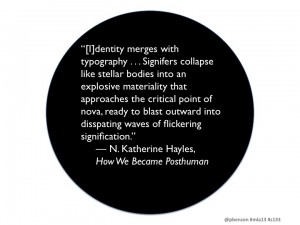
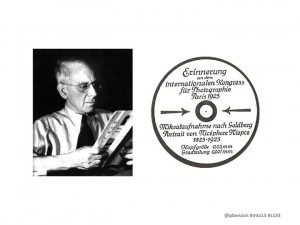

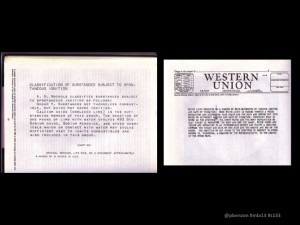
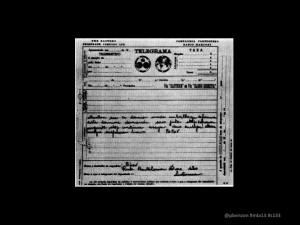
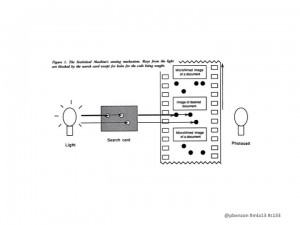



[…] was Reading the Invisible and Unwanted in Old and New Media, and it was assembled by Lori Emerson, Paul Benzon, Zach Whalen, and […]
[…] Account of Randomness in Literary Computing,” by Mark Sample Lost in Plain Sight: Microdot Technology and the Compression of Reading, by Paul […]